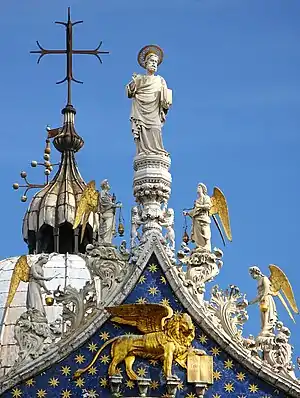832
Year 832 (DCCCXXXII) was a leap year starting on Monday (link will display the full calendar) of the Julian calendar, the 832nd year of the Common Era (CE) and Anno Domini (AD) designations, the 832nd year of the 1st millennium, the 32nd year of the 9th century, and the 3rd year of the 830s decade.
| Millennium: | 1st millennium |
|---|---|
| Centuries: | |
| Decades: | |
| Years: |
| 832 by topic |
|---|
| Leaders |
|
| Categories |
|
| Gregorian calendar | 832 DCCCXXXII |
| Ab urbe condita | 1585 |
| Armenian calendar | 281 ԹՎ ՄՁԱ |
| Assyrian calendar | 5582 |
| Balinese saka calendar | 753–754 |
| Bengali calendar | 239 |
| Berber calendar | 1782 |
| Buddhist calendar | 1376 |
| Burmese calendar | 194 |
| Byzantine calendar | 6340–6341 |
| Chinese calendar | 辛亥年 (Metal Pig) 3528 or 3468 — to — 壬子年 (Water Rat) 3529 or 3469 |
| Coptic calendar | 548–549 |
| Discordian calendar | 1998 |
| Ethiopian calendar | 824–825 |
| Hebrew calendar | 4592–4593 |
| Hindu calendars | |
| - Vikram Samvat | 888–889 |
| - Shaka Samvat | 753–754 |
| - Kali Yuga | 3932–3933 |
| Holocene calendar | 10832 |
| Iranian calendar | 210–211 |
| Islamic calendar | 216–217 |
| Japanese calendar | Tenchō 9 (天長9年) |
| Javanese calendar | 728–729 |
| Julian calendar | 832 DCCCXXXII |
| Korean calendar | 3165 |
| Minguo calendar | 1080 before ROC 民前1080年 |
| Nanakshahi calendar | −636 |
| Seleucid era | 1143/1144 AG |
| Thai solar calendar | 1374–1375 |
| Tibetan calendar | 阴金猪年 (female Iron-Pig) 958 or 577 or −195 — to — 阳水鼠年 (male Water-Rat) 959 or 578 or −194 |
Events
Byzantine Empire
Europe
- King Pepin I of Aquitaine, and his brother Louis the German, revolt against their father, Emperor Louis the Pious. They gather an army of Slav allies and conquer Swabia.
- Berengar the Wise, count (or duke) of Toulouse, attacks the Frankish domains of Bernard of Septimania, taking Roussillon (along with Vallespir, Razès, and Conflent).
Britain and Ireland
- The Flag of Scotland: According to legend, King Óengus II of Fortriu leads an army of Picts and Scots, against the invading Angles from Northumbria, near Athelstaneford.
- The town of Clondalkin (modern Ireland) is sacked by Vikings from Denmark, and the monastery is burnt to the ground.
Religion
- Emperor Theophilos promulgates a new edict against the usage of icons in the Byzantine Empire. He establishes strict punishments against idolators, and persecutes violators.
- The second St. Mark's Basilica in Venice (replacing an older church at a different location) is built, and becomes one of the best known examples of Italo-Byzantine architecture.
Births
Deaths
References
- Brooks 1923, p. 128.
- Bury 1912, pp. 254, 474–477.
Sources
- Brooks, E. W. (1923). "Chapter V. (A) The Struggle with the Saracens (717–867)". The Cambridge Medieval History, Vol. IV: The Eastern Roman Empire (717–1453). Cambridge: Cambridge University Press. pp. 119–138.
- Bury, John Bagnell (1912). A History of the Eastern Roman Empire from the Fall of Irene to the Accession of Basil I (A.D. 802–867). London: Macmillan and Co.
This article is issued from Wikipedia. The text is licensed under Creative Commons - Attribution - Sharealike. Additional terms may apply for the media files.
